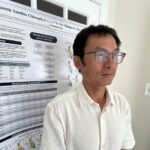Mathematics of Planet Earth 2013
By: Phil Arkin
In January I am normally in a southern US city attending the American Meteorological Society annual meeting. This week, I am in San Diego attending a different AMS – the American Mathematical Society Joint Mathematics Meetings. I am helping to organize a special session on environmental mathematics during which mathematicians and environmental scientists describe methods for modeling and observing climate. Our session is a part of Mathematics of Planet Earth 2013 (MPE2013), a joint effort of more than 100 scientific societies, universities, research institutes, and organizations all over the world. A number of sessions and invited addresses at this meeting are devoted to the topic.
While the attendance here seems large, it is very unlike the other AMS for me in that I know few of the attendees and so I find it easy to sit in on sessions and actually pay attention to the content. This morning I listened to several talks on integrating the mathematics of planet earth into college mathematics curricula. I came away with the impression that the large amount of data and analyses available make climate an outstanding virtual laboratory for introducing their students to the use of mathematics in the “wild”. I was impressed with the wide range of topics and tools that these faculty members were introducing their undergraduate students to. In one case, students were expected to learn and use MATLAB (something I have been unable to do myself, sadly), and by the end of the course to run experiments using the Weather Research and Forecasting (WRF) model.
Tomorrow morning is the first of the two parts of our special session, and since one of our speakers was unable to come I need to prepare something to fill that gap. I will try to report again tomorrow on our session and other interesting events.





